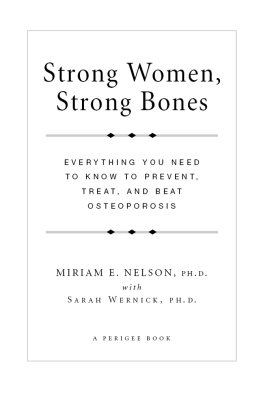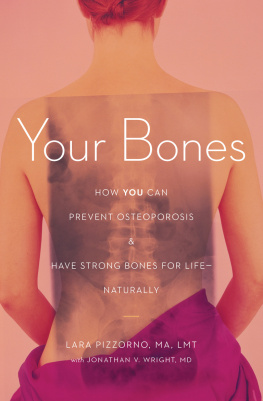Exercise for Better Bones
The Complete Guide to Safe and Effective Exercises for Osteoporosis
Margaret Martin, PT, CSCS
Exercise for Better Bones
The Complete Guide to Safe and Effective Exercises for Osteoporosis.
Copyright 2015 by Margaret Martin.
Photography: Richard Martin
Interior Design: Richard Martin
Video Production: Richard Martin
All rights reserved. This book was self-published by Margaret Martin under Kamajojo Press. All of the content in this book is owned by Margaret Martin and is protected by worldwide copyright laws. The trademarks, service marks, trade names, and trade dress featured in this book are protected by the laws of the United States, Canada and those of other countries and jurisdictions around the world.
This book may not be reproduced, in whole or in part, including illustrations, in any form (beyond that copying permitted by Sections 107 and 108 of the U.S. Copyright Law and except by reviews for the public press), without the written permission from the author. This includes reprints, excerpts, photocopying, recording, or any future means of reproducing the text or photos.
For information on getting permission for reprints and excerpts, contact Richard Martin at info@melioguide.com.
Published in Canada by Kamajojo Press.
ISBN-13 : 978-0991912551
Version 4.0
Find us on the Web at www.melioguide.com
To report errors, please send a note to info@melioguide.com
Exercise for Better Bones
Table of Contents
Acknowledgements
T he development of my website, the professional workshops, the online professional training courses, and this guide were made possible by the tireless support from, encouragement of, and thousands of hours of skilled labor by my husband, Richard.
This guide is dedicated to my many clients who were initially fearful of moving and breaking a bone when they were first told that they had osteoporosis. Helping them build their confidence and strength motivated me to reach out to others with similar challenges. Their questions helped me become a better Therapist.
I would especially like to acknowledge my clients who posed for earlier versions of the manual and website, especially Aline Young and Pat Heydon for their willingness to sit through the revised version of the site and guide. I thank them for their time, their patience, and their unending smiles.
I need to acknowledge the contributions of all the Physical Therapists, Physiotherapists, Occupational Therapists, Kinesiologists, and other health care professionals that I have had the privilege of training around the world both online and live workshops. Your feedback and recommendations have improved the site, this manual, and my books. I would especially like to thank Holly Bonasera and Betsey Newcomb for reviewing early drafts of this guide and Marian Weldon and Karen Kemmis for their support and encouragement during the early stages of this project. A thank you to Sara Meeks for teaching me the importance of posture and alignment in the treatment of osteoporosis.
Hundreds of researchers have studied the effects of exercise on bone. Without their dedication and perseverance, we would not understand the benefits and risks of exercise. To the Doctors of Physical Therapy, Kathy Shipp at Duke University, Meena Sran at University of British Columbia, and Wendy Katzman at University of California in San Franscisco, thank you for your support and feedback during the development of MelioGuide.
Lastly, to our children, John and Katherine, who claim to be the only Millenials who know everything there is to know about building stronger bones. Thank you for letting us spill out our ideas and excitement around the house and cottage.
Margaret Martin
Physical Therapist, Certified Strength and Conditioning Specialist
July, 2015
Ottawa, Canada
1. Welcome
C ongratulations! You have made a significant step towards building healthier, stronger bones and reducing your risk of a fracture. I am looking forward to working with you as you build both your bones and your confidence!
Medical research has shown over and over again that exercise is a critical component in building and maintaining strong bones and reducing the risk of a fracture 1,2 . The research and scientific data supporting the benefits of exercise on bones is quite convincing.
I find the positive results of a well-designed bone building exercise program on clients at my Physiotherapy clinic to be very motivating. I hope that you experience the same level of excitement, achievement, and confidence as you follow the Exercise for Better Bones program in this guide.
I am fortunate to work with all kinds of people and watch them build their confidence as they develop their strength, balance, flexibility, and cardiovascular endurance, and improve their posture. In addition to developing exercise programs appropriate to their fracture risk and activity level, I also teach them that everyday activities and positions can lead to a fracture and, as a result, would best be modified. My objective with this guide is to share this knowledge and information with a larger audience.
Why did I decide to write a guide dedicated to exercise for osteoporosis? It all started when a number of my clients at my Physiotherapy clinic had friends and family in need of an exercise program for osteoporosis but, because the friend or family member lived too far away for me to consult with in-person, my clients asked me if there were any exercise programs that I could recommend that were available online or in print. I searched online and reviewed different books and publications for exercise programs that I thought would be appropriate to recommend.
I was unable to find anything I felt was comprehensive enough to recommend to anyone interested in an exercise program for osteoporosis. The exercise programs that were available online or in print were limited in scope (do weight bearing exercises to build bone), did not take into account the individuals activity level and fracture risk, or were (in some cases) not based on scientific evidence.
I believe that an exercise program for the prevention and management of osteoporosis cannot take a one-size-fits-all approach, must cover a wide range of exercise activities that address balance, strength and flexibility, and must be supported by scientific evidence. The program must be designed to provide enough stress on the skeletal structure to encourage bone strengthening as well as allow you to develop the balance and strength required to reduce the chance of a fall. At the same time, there had to be a way to easily allow you to determine what program would be most appropriate for you based on your medical and activity profile. Finally, I felt that the program had to continually challenge you and keep you engaged and be fun!
Four Principles
The single thing that comes close to a magic bullet ... is exercise.
- Dr. Frank Hu
Epidemiologist
Harvard School of Public Health
As we age, our bone density decreases potentially leading to osteoporosis. In fact, our bone density peaks at around the age of 30. The rate of decline depends on a number of factors and generally women experience a more dramatic decline than men. Fortunately, an exercise program designed to strengthen your bones can play a key role in slowing that rate of decline.
Studies show that regular weight bearing exercise and strength training can increase bone density in older adults by at least 1% per year. This may not sound like a lot, but it is significant considering that without the appropriate exercise, you could lose 1% or more bone density per year.
Next page








